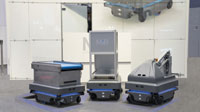
Posted to News on 28th May 2019, 00:00
Autonomous mobile robots support a lean approach to operations
The fast and easy integration of autonomous mobile robots make them capable of adding new efficiencies almost immediately. With low initial costs and fast optimisation of processes, they offer fast return on investment – often in less than six months.

As manufacturers embrace a lean approach to operations, executives are evaluating their opportunities to continually optimise productivity. Even in highly automated facilities, material handling is often still a manual, inefficient process, but automating material transportation to reduce production bottlenecks and deploy valuable human workers more effectively has been a challenge. Decision-makers have been faced with expensive investments in automated guided vehicles (AGVs), which don’t provide the flexibility needed in today’s agile manufacturing processes. But new sensor and software technologies make autonomous mobile robots (AMRs) ideal for unpredictable or changing production layouts and dynamic work environments.
Agile manufacturing is allowing companies to adapt to fast-changing market demands and maintain their competitiveness, but on-time delivery of materials and assemblies within those facilities continues to be a challenge. Manual transportation requires workers to leave their stations to push carts loaded with materials between manufacturing processes and the stockroom, and can result in production backlogs and idle workers as they wait for assemblies and parts to be delivered. Automating this process has been a challenge.
Plant set-up is often dynamic, with new production cells and processes that must be supported and people, equipment, pallets, and other obstacles can appear in what used to be open passageways. Any automated material transportation approach must be flexible and easily adaptable without additional cost or disruption to processes, not to mention safe for operation around employees. That flexibility also means that automated material handling must be easy to learn, program, deploy, and redeploy in-house to ensure that the chosen approach can cost-effectively keep up-to-date with requirements. Traditional automated guided vehicles (AGVs) move materials using fixed routes that are guided by permanent wires, magnetic strips, or sensors embedded in the plant floor. However, those systems are inflexible, expensive, and disruptive for dynamic manufacturing floors. If manufacturing processes change, the facility must be updated again – and if people or material temporarily blocks the AGV’s route, it simply stops until the way is cleared. In contrast, today’s autonomous mobile robots (AMRs) are designed for dynamic environments. They offer the flexibility, safety, and cost-effectiveness that allows companies of nearly any size to automate and optimise material handling.
An AMR navigates via sensors, cameras, and sophisticated software that is built into the robot itself, without the need for external sensors or guides. Once the robot has learned its surroundings (either by uploading a facility blueprint or by piloting the robot around the plant to develop its own map), the robot recognises its surroundings and can take the most efficient route to its destination autonomously, safely avoiding obstacles and people. Because companies do not need to alter their facility with wires or sensors, the robot can be integrated within hours with no disruption to production.
Magna-Power, a New Jersey-based manufacturer of power products, has deployed two Mobile Industrial Robots (MiR) AMRs to move parts and assemblies from the stockroom and through its vertically integrated manufacturing floor. This easy deployment of the MiRs meant that they were ready to start working in just a few hours. “One thing that was pretty astonishing for me is that the MiR robot was delivered and 15 minutes later it was unpacked and on the floor,” says Adam Pitel, Magna-Power VP of operations. “In another 15 minutes, I’m controlling it with my mobile phone, and within two hours it is travelling from point to point in our building, after uploading a schematic of our facilities.”
AMRs adds efficiency to a number of operations related to production and material handling. As businesses grow, AMR implementation can expand simultaneously with minimal additional costs. Moreover, the AMR is collaborative and can be used in nearly any situation where employees are spending time pushing carts or making deliveries, allowing companies to automate these low-value tasks so employees can focus on higher-value activities.
At Magna-Power the implementation of the two MiRs has freed the equivalent of three full-time employees, who can now focus on the tasks they were hired to do. “The purpose of the robot is not to replace employees, but to make them more efficient with their time,” says Grant Pitel, Magna-Power’s VP of engineering. “Now they can focus on the things that we can’t get a robot to do.”
AMRs can perform the monotonous and repetitive tasks of material transportation without breaks that can disrupt the assembly process. NewForm, a manufacturer of Italian-designed bath taps and fittings, sees these benefits as well with its two MiR robots.
Damiano Marconi, NewForm’s technical assistant, says, “Now our lines are active on a 24/7 ‘lights out’ basis, because they are automatically loaded and unloaded.” Moreover, the MiRs are integrated with NewForm’s production planning system and provide a real-time overview of materials. “We can guarantee a real-time production control. The very simple integration software can easily communicate with both our machine tools and our data server, so we can easily track every piece, its position and condition in real-time.”
Modern manufacturing environments can no longer be dependent on costly, inflexible legacy technologies. Nor can they afford to continue the unproductive manual transportation of materials, especially in today’s tight labour market. Autonomous mobile robots offer an agile alternative to AGVs or manual delivery, providing flexibility, cost-effectiveness, return on investment, and productivity optimisation.









